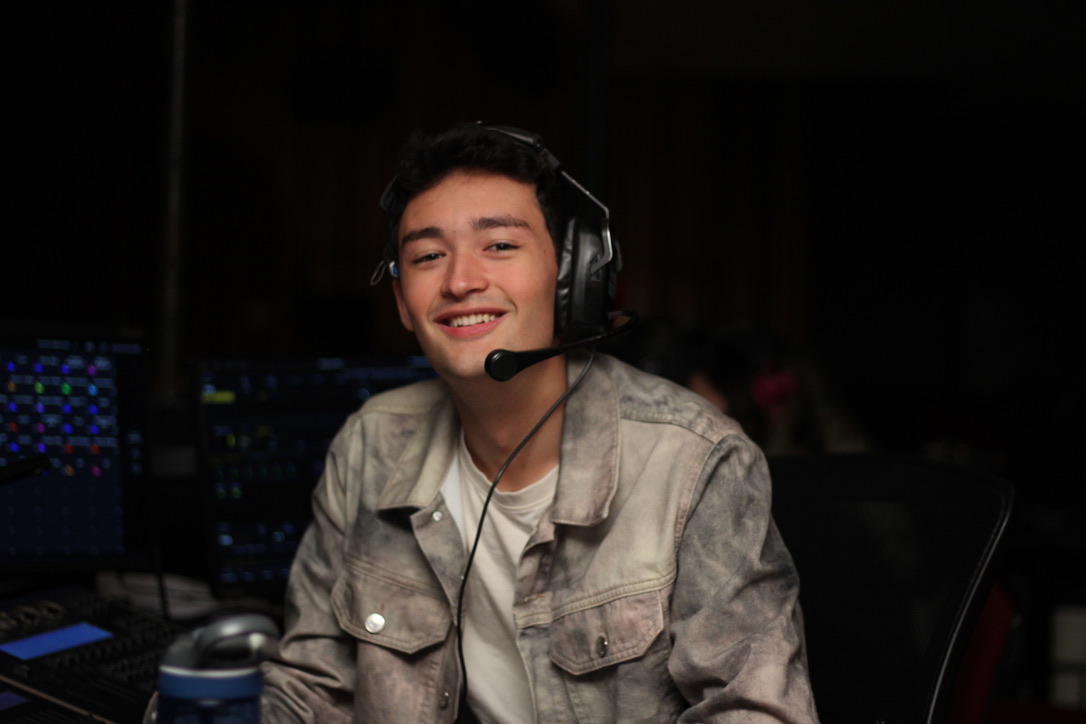
News
Pro-Palestine Encampment Represents First Major Test for Harvard President Alan Garber

News
Israeli PM Benjamin Netanyahu Condemns Antisemitism at U.S. Colleges Amid Encampment at Harvard

News
‘A Joke’: Nikole Hannah-Jones Says Harvard Should Spend More on Legacy of Slavery Initiative

News
Massachusetts ACLU Demands Harvard Reinstate PSC in Letter

News
LIVE UPDATES: Pro-Palestine Protesters Begin Encampment in Harvard Yard
Artist Profile: Finn M. Bamber ’23 on the Quiet Language of Light

In his freshman year of high school, Nicholas “Finn” M. Bamber ’23 was the only student to show up for light board training — so the theater director told him, “you’re doing it,” to which Bamber replied,“okay.”
“This happened a few more times, and then now somehow, I’m here,” Bamber said.
Now a college graduate, the longtime lighting designer leaves Harvard with over 50 productions under his belt as well as a degree in Theater, Dance, & Media and a secondary field in Art, Film, and Visual Studies. Bamber has been involved in a wide variety of performances, including musicals, departmental plays, dance shows, operas, Zoom productions, and more. In recognition of his work, he was recently honored by the Office for the Arts at Harvard with the Louise Donovan Award for “outstanding work behind the scenes in the arts.”
“I feel like everyone who gets into theater design — I think this is particularly true of lighting design — kind of falls in, finds their way, in a really unique way,” Bamber said.
Initially interested in acting, he had just transferred to a new high school when the theater director called for student lighting designers. Because it was too late to audition for a role, Bamber serendipitously began his technical theater career.
At Harvard, Bamber’s involvement with theater was almost exclusively lighting design — along with some unofficial stage managing, directing, and scenic design. He also served as a proctor for the First-Year Arts Program and a board member of the Harvard-Radcliffe Dramatic Club. Prioritizing lighting design over the majority of his other commitments, he plans to continue working in this field after graduation. Although these plans are subject to change, he has decidedly settled into design as his “happy place.”
Bamber’s post-graduation philosophy is driven by plain passion.
“If you want to do the thing, you have to do the thing — and so I’m going to do the thing,” he said.
When Bamber sat down for an interview with The Harvard Crimson, he had just finished work on his final collegiate project, “Ugly Feelings,” a senior thesis play by Karina L. Cowperthwaite ’23. Staged in the intimate Loeb Experimental Theater, it was just one of the experimental, emotional productions that Bamber finds interesting. He cites timing, expressive potential, and exciting collaborators as draws to a particular project. These collaborators range from Harvard classmates to independent theater groups, including The Goat Exchange and Moonbox Productions.
Once he joins a project, Bamber grapples with how to channel abstract themes and story arcs into concrete visualizations.
“How do you image the idea of love, for example?” he asked.
Bamber’s other passion, photography, helped hone his understanding of conveying information through visual aesthetics. In photography classes, he learned how to deconstruct images, discover their intended meanings, and extrapolate these tactics to frame “the world as a picture.”
Bamber emphasizes the importance of interaction when it comes to crafting these visualizations. He especially likes to talk to other designers and choreographers.
“What kind of world are we coming together to make? Because it really is an act of coming together and making art, and no one can do it alone,” he said. “You know, if my light lands on empty space, it doesn’t look like much until an actor enters.”
When it comes to stage lighting, Bamber prioritizes color, intensity, and focus. In past sets, his toolbox has also included neon lettered signs, an antique chandelier, and wires dripping with light bulbs. In the geometric world of “Marriage or Maid/MADE,” Bamber controlled colored LED lights lining a series of door frames.
Though these pieces are visually striking, Bamber’s choices are not always obvious to viewers. When it comes to theatrical storytelling, Bamber finds thoughtful lighting design to be subtle yet deeply effective.
“Lighting design is crazy because arguably, done well, it’s something that you as an audience member, like 99.5% of the audience, never notices,” he said.
The audience rarely consciously thinks about light; instead, instinct determines reaction. Even as a quieter aspect of the production process, lighting design is essential to establish mood and give unspoken cues about time, place, and central action.
“We as humans — our circadian rhythm is entrained by light,” Bamber said. “That’s one of the few ways that we can know what’s going on. And that’s not something that we necessarily register.”
It is easy to forget that darkness plays a role as important as light, but Bamber uses it to direct the audience’s attention.
“Lighting design is as much about where you want people to look as it is about where do you not want people to look,” he said, comparing it to a magician’s redirects.
Ultimately, Bamber enjoys theater because of the joy of “creating experiences” in an inclusive community. Amidst the meticulous technical planning and hectic collaboration, he cherishes moments of “magic” where all the components come together in live performance.
Bamber’s artistic experiences have cultivated his unique awareness and analysis of visual culture. Giving advice to prospective theater designers, he reflected on the importance of creating as much work as possible, developing design sensibilities through examining other art, and paying attention to the hidden aspects of everyday life.
“Practice as an artist. And then the other piece of advice I would give is see everything,” Bamber said. “Do everything and see everything.”
Want to keep up with breaking news? Subscribe to our email newsletter.
